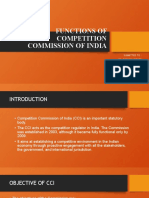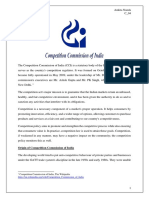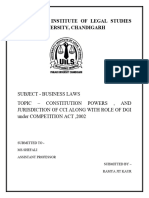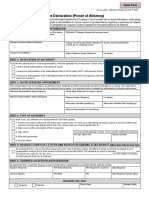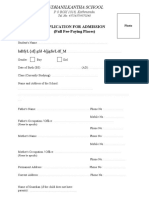Business Assignment
Uploaded by
karanvirmander77Business Assignment
Uploaded by
karanvirmander77The Competition Commission
of India
Introduction
The liberalization of the Indian economy in 1991 marked a
pivotal shift from a command-and-control regime to a
market-driven system. The need for a modern competition
law became evident with the inadequacies of the Monopolies
and Restrictive Trade Practices (MRTP) Act, 1969.
Consequently, the Competition Act, 2002, was enacted,
leading to the establishment of the Competition
Commission of India (CCI).
Historical Background and Need for CCI
The MRTP Act focused more on curbing monopolies rather
than fostering competition. The Raghavan Committee
(2000), formed to review the existing competition laws,
strongly recommended replacing the MRTP Act with a new
law suitable for the changing economic scenario. The result
was the Competition Act, 2002, which came into full force
by 2009.
The CCI was officially established in October 2003, and
became fully functional in May 2009 with enforcement and
adjudicatory powers. It functions as a quasi-judicial body
under the Ministry of Corporate Affairs.
Objectives of the CCI
As per Section 18 of the Competition Act, the primary
objectives of the CCI include:
• Preventing practices having an adverse effect on
competition
• Promoting and sustaining competition in markets
• Protecting the interests of consumers
• Ensuring freedom of trade carried on by other
participants in Indian markets
Constitution of the Competition
Commission of India (CCI)
Legal Provision: Section 7 to 17 of the
Competition Act, 2002
Key Features:
• Statutory Body established by the Central
Government.
• Successor to the Monopolies and Restrictive Trade
Practices Commission (MRTP Commission).
• Comprises:
◦ Chairperson (appointed by the Central
Government),
◦ Minimum of two and a maximum of six other
Members.
• The Chairperson and members must have professional
expertise in law, economics, commerce, industry,
public affairs, or competition matters.
Headquarters:
• Located in New Delhi.
Powers and Functions of the CCI
(Sections 18 to 39 of the Competition Act,
2002)
The CCI is empowered with quasi-legislative, quasi-
judicial, and quasi-executive powers to enforce the
Competition Act effectively.
A. Prevent Anti-Competitive Practices (Section
18)
• Duty to eliminate practices having an adverse effect
on competition (AAEC).
• Protect the interests of consumers and ensure
freedom of trade.
B. Inquiry and Investigation
i. Anti-Competitive Agreements and Abuse of
Dominance (Sections 3 & 4):
• CCI can inquire into any agreement or conduct
that:
◦ Causes or is likely to cause AAEC in India.
◦ Includes price fixing, bid rigging, market
allocation, and abuse of dominance.
ii. Regulation of Combinations (Sections 5, 6, 20,
29, 30, 31):
• CCI examines mergers, acquisitions, and
amalgamations that may cross prescribed thresholds.
• Power to approve, modify, or prohibit a
combination.
C. Power to Conduct Investigation (Section 26)
• Can direct the Director General (DG) to conduct
investigations.
• DG has powers similar to a civil court in investigating
companies, summoning documents, examining persons
on oath, etc.
D. Interim Orders (Section 33)
• Can pass interim injunctions during ongoing
proceedings to prevent irreversible damage.
E. Orders and Remedies (Section 27, 28)
• Direct the enterprise to discontinue or modify
practices.
• Impose penalties up to 10% of average turnover or
3 times the profit.
• Order division of enterprises if abuse of
dominance is proven.
F. Penalties (Sections 42–48)
• For non-compliance with orders or false
statements, including:
◦ Monetary fines,
◦ Imprisonment (via Chief Metropolitan
Magistrate) for egregious violations.
G. Advocacy and Research (Section 49)
• CCI is mandated to promote competition advocacy,
awareness, and training.
• Can give opinions to statutory authorities on
competition-related policy matters.
H. Enforcement of Orders (Section 39)
• CCI orders are enforceable as decrees of a civil
court.
• May recover penalties and costs in the same manner as
taxes due to the government.
Jurisdiction of the CCI
A. Territorial Jurisdiction
• The CCI has nationwide jurisdiction.
• Can inquire into agreements and conduct that have an
effect on competition in India, even if outside
India:
◦ Example: “Effect doctrine” under Section 32
empowers CCI to act against anti-competitive
conduct taking place outside India but having
appreciable adverse effect on Indian
markets.
B. Subject-Matter Jurisdiction
• Covers:
◦ Anti-competitive agreements (Section 3),
◦ Abuse of dominance (Section 4),
◦ Combinations (Sections 5 and 6).
C. Extraterritorial Jurisdiction [Section 32]
• CCI may investigate and pass orders in cases where:
◦ The agreement is executed outside India,
◦ A party resides outside India,
◦ The dominant position is held outside India,
◦ But the effect is within India
Key Decisions and Case Law
DLF Ltd. Case (2011)
• Issue: Abuse of dominant position in real estate.
• Decision: CCI imposed a penalty of ₹630 crore for
one-sided agreements with flat buyers.
Google Android Case (2022)
• CCI imposed ₹1,337 crore penalty for abuse of
dominance in the Android ecosystem.
• Ordered changes in business practices and licensing
terms.
Amazon-Future Coupons (2021–2022)
• Suspended Amazon’s deal for failing to disclose key
information during merger notification.
• Penalty imposed under Section 43A.
Cement Cartel Case
• Heavy penalties on cement manufacturers for
cartelization and price fixing.
Judicial Review and Appeals
Decisions of the CCI can be appealed to the National
Company Law Appellate Tribunal (NCLAT) under
Section 53B, and thereafter to the Supreme Court under
Section 53T. Judicial oversight ensures checks and balances
on the Commission’s powers.
Challenges and Criticisms
• Delay in Adjudication: Long-drawn inquiries reduce
effectiveness.
• Need for Greater Transparency: Some decisions
lack detailed reasoning.
• Digital Markets: Difficulty in regulating global digital
giants with evolving market dynamics.
• Overlap with Sectoral Regulators: Jurisdictional
conflicts with TRAI, SEBI, etc.
Recent Developments and Amendments
Competition (Amendment) Act, 2023 Highlights:
• Introduction of settlement and commitment
mechanisms.
• Reduced timeline for merger control from 210 to 150
days.
• Inclusion of hub-and-spoke cartel framework.
• Definition of “turnover” clarified to mean “global
turnover” for penalty computation.
Conclusion
The Competition Commission of India (CCI) is the
cornerstone of India’s competition enforcement
framework. It plays a vital role in:
• Monitoring anti-competitive practices,
• Promoting fair markets,
• Protecting consumer interests, and
• Ensuring sustainable economic growth.
The CCI’s success in enforcement depends on efficient
institutional functioning, timely intervention, and
the ability to evolve with changing market dynamics,
especially in the era of the digital economy.
Bibliography
1. The Competition Act, 2002
2. Official website of Competition Commission of India:
https://www.cci.gov.in
3. Raghavan Committee Report, 2000







